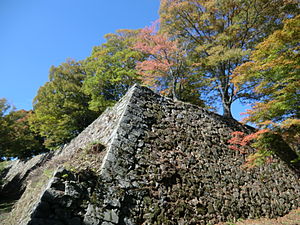Takatori Castle
| Takatori Castle | ||
|---|---|---|
|
Takatori Castle |
||
| Creation time : | Mid 16th century | |
| Castle type : | Yamajiro (mountain castle) | |
| Conservation status: | Walls preserved | |
| Place: | Takatori | |
| Geographical location | 34 ° 25 '44.4 " N , 135 ° 49' 36.9" E | |
|
|
||
The Castle Takatori ( Japanese 高取城 , Takatori-jō ) is located in the town of Takatori , Nara Prefecture . In the Edo period , the Uemura last resided there as a smaller Fudai daimyo . Takatori Castle is one of the "Three Great Mountain Castles of Japan" ( 日本 三大 山城 , Nihon sandai yamashiro ).
Lords of the castle in the Edo period
history
The castle was built at 583 m above sea level, or 390 m above the valley on the Takatori mountain. It was Honda Toshitomo ( 本 多 利 朝 ; † 1566), a higher vassal of Toyotomi Hidenagas ( 豊 臣 秀 長 ; 1540–1591) who repaired the mountain castle from the beginning of the Middle Ages. Even after Hidenaga's death, the Honda lords remained. In 1600, Tokugawa Ieyasu increased Honda's income to 25,000 koku. That was the time when the castle was given its final shape. In 1640 the Uemura took over the castle and resided there until the Meiji Restoration in 1868.
The attachment
Actually, the regulation on the behavior of the Buke, i.e. the sword nobility , the Buke Shohatto ( 武 家 諸法 度 ), forbade the building of extensive castle complexes . But under certain circumstances it was possible to invoke “usual renovation” ( 常 普 請 , Tsune fushin ). And so an unusually complex system was built. The buildings on the mountain, painted in white, gave rise to the saying "If you see snow on Takatori in the south-west, it is Tosa Castle."
The central area, the Hommaru ( 本 丸 ), the second and third areas Ni-no-maru ( 二 ノ 丸 ) and San-no-maru ( 三 ノ 丸 ) ran along the top. In the Hommaru stood the three-story castle tower ( 天 守 閣 , tenshukaku ), supplemented by a small three-story castle tower. The pre-areas Tsubozakaguchi-kuruwa ( 壺 坂口 曲 輪 ) and Yoshinoguchi-kuruwa ( 吉野 口 間 輪 ) protected the corresponding entrances. There were also watchtowers with somewhat fancy names; the Enshō watchtower ( 烟硝 櫓 , Enshō-yagura ), the "lead watchtower" ( 鉛 櫓 , Namaru-yagura ) and the "armor watchtower" ( 具足 櫓 , Guzoku-yagura ). They were connected by bastions occupied by long houses.
Today the completely preserved walls are registered as “National Traces of History” ( 国 史跡 , Kuni shiseki ). Remains of the earth walls and ditches are also visible. A castle gate was moved to the city of Takatori.
Remarks
- ↑ The other two are Iwamura Castle and Matsuyama Castle (Bitchu) .
- ↑ In Japanese: 「巽 高 取 雪 か と 見 れ ば 、 雪 で は ご ざ る ぬ 土 佐 の 城」 , where "Tosa" stands for the castle town of Takatori .
literature
- Hashiba, Akira: Takatori-jo in: Miura, Masayuki (ed.): Shiro to jinya. Saikoku-hen. Gakken, 2006. ISBN 978-4-05-604379-2 .
- Nishigaya, Yasuhiro (Ed.): Takatori-jo. In: Nihon meijo zukan, Rikogaku-sha, 1993. ISBN 4-8445-3017-8 .


